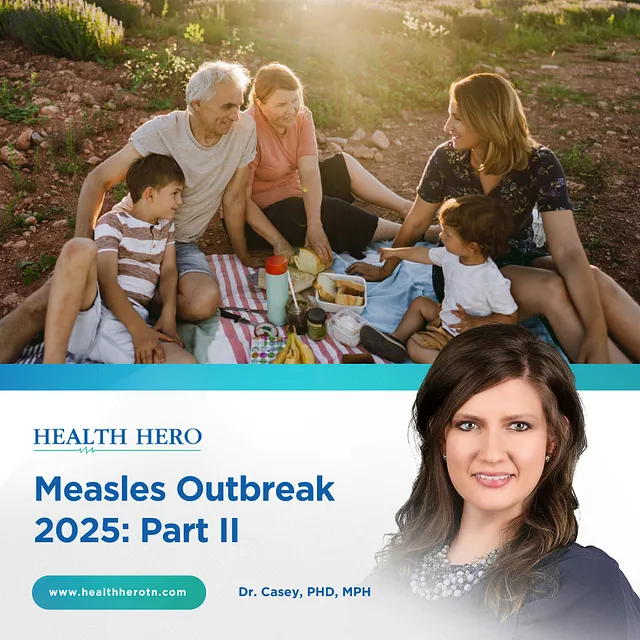It has been a whirlwind year for illnesses. Bird flu outbreaks, a particularly intense influenza season, and measles outbreaks have all made headlines. Each of these stories shares a common thread: a warning about exposure risks and the need for proactive protection. With some of these illnesses now appearing more frequently in our communities, it’s never been more important to make sure children’s immune systems are prepared to face these threats.
A Flu Season Like No Other
This year’s flu season is shaping up to be the deadliest since 2018. In just January and February, nearly 9,800 Americans lost their lives to influenza — almost double the number from the same period last year. In Tennessee alone, flu-related hospitalizations have risen by more than 30% in just the past month.
This is a major risk to children as they enter crowded environments where flu can spread easily. While most children recover from the flu at home, certain symptoms can indicate serious complications that require medical attention. These include:
● Fast or labored breathing
● Persistent high fever (especially over 104°F or lasting more than 3 days)
● Extreme fatigue or trouble waking up
● Bluish lips or face
● Severe muscle pain or complaints of leg pain
● Signs of dehydration (dry mouth, no tears when crying, no urine for 8 hours)
● Seizures or confusion
● A fever that goes away but then returns worse
If your child shows any of these symptoms, it’s important to seek medical attention.
The Return of Measles
While the flu has been in the headlines, measles has also become a serious concern in communities across the U.S., including recent outbreaks in states like Ohio, Florida, and New York. This highly contagious disease was declared eliminated in the U.S. in 2000, but falling vaccination rates are allowing it to creep back into our schools and neighborhoods.
Measles is more contagious than the flu or COVID-19. It can live in the air for up to two hours after an infected person coughs or sneezes, and up to 9 out of 10 unvaccinated people exposed to it will become infected.
Symptoms include:
● High fever
● Cough
● Runny nose
● Red, watery eyes
● A telltale rash that spreads from the face downward
What makes measles especially dangerous is its potential to cause serious complications, including:
● Pneumonia
● Brain swelling (encephalitis)
● Hearing loss
● Death (especially in young children and those with compromised immune systems)
The MMR vaccine (measles, mumps, rubella) is the best tool to fight against measles. Two doses provide about 97% protection. But national coverage is slipping. In 2023, U.S. kindergarten vaccination rates for MMR dropped to their lowest levels in over a decade. This leaves entire communities vulnerable, especially babies too young to be vaccinated and children with medical conditions that prevent immunization.
The Results of Vaccine Hesitancy
Despite these rising threats, fewer Americans are choosing to vaccinate, and kids are caught in the middle. Misinformation has created a dangerous wave of vaccine hesitancy. States are seeing a 16% drop in flu vaccine distribution since 2022, and many have even rolled back school vaccination requirements.
This growing distrust is putting younger people at risk. In communities where fewer children are vaccinated, the flu and measles can easily spread. Getting vaccinated for both remains one of the most effective tools we have to reduce severe illness, hospitalizations, and death.
The Facts: Flu Vaccines Save Lives
There are several common misconceptions about the flu vaccine, such as:
● “The flu shot gave me the flu.” This is not possible. The vaccine contains inactivated virus and cannot cause the illness.
● “I got the shot and still got sick.” Flu vaccines may not prevent every infection, but they significantly reduce the severity and risk of complications.
● “Kids don’t need the flu shot.” In fact, children under 5 — especially under 2 — are at higher risk of serious flu-related complications like pneumonia, dehydration, and, in rare cases, death.
The Facts: Measles Vaccines Are Critical
Measles also comes with a variety of misconceptions, including:
● “Measles isn’t that serious.” Measles can be extremely dangerous to children. It can lead to pneumonia, brain swelling (encephalitis), hearing loss, and even death.
● “We don’t need the measles vaccine anymore — it was eliminated.” While measles was declared eliminated in the U.S. in 2000, outbreaks are on the rise again due to declining vaccination rates. It only takes one case to spread rapidly in an unvaccinated community.
● “My child doesn’t need it yet.” Children should receive their first dose at 12–15 months and a second dose between 4–6 years. Skipping or delaying puts them at risk during outbreaks.
What Parents Can Do Now
It’s not too late to get the protection your child needs. Here’s how you can help reduce the spread and protect your kids:
● Get vaccinated — Scheduling an appointment only takes a few minutes, and there are several resources available to see where vaccines are offered.
● Practice good hygiene — Encourage kids to wash their hands regularly, cover their coughs and sneezes, and stay home when sick.
● Stay informed — Follow updates from the Tennessee Department of Health and the CDC to monitor flu activity and recommendations.
Sources:
CDC: Influenza Vaccine Doses Distributed
CDC: Measles Cases and Outbreaks
National Foundation for Infectious Disease: Myths and Facts About Influenza (Flu)
National Foundation for Infectios Disease: Frequently Asked Questions about Measles


